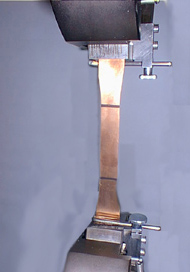 Copper speciment showing gage marks for tracking with Instron video extensometer.
Copper speciment showing gage marks for tracking with Instron video extensometer.Photo Courtesy of Instron Corp.
Elongation is reported as a percent increase in the original sample gauge length and is always measured after a sample fractures. Gauge length is usually determined by inscribing gauge marks on the sample prior to testing and measuring the distance between them. Because elongation is always reported as a percentage, original gauge must be reported. Two inches is the standard gauge length for strip tensile specimens and this is how the data are generally reported.
The reduction in area is reported as a percent decrease in the original cross-sectional area and it, like percent elongation, is measured after a sample fractures. Copper alloys are typically specified using the percentage elongation value, but it can be argued that the percentage reduction in area would be preferable. The percent elongation is more a measure of the strain leading to the onset of necking than a measure of the strain at final fracture in a uniaxial tensile specimen. A better measure of the strain at final fracture is the percent reduction in area. The percent elongation can be a useful specification, by connector manufacturers, in order to better match their design requirements (e.g. minimum bend requirements) to the materials total ductility.
